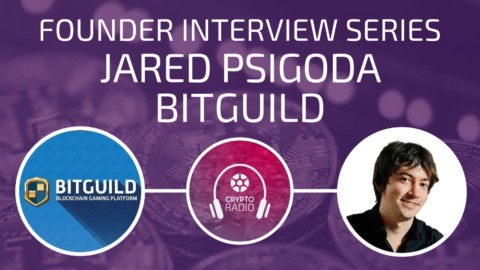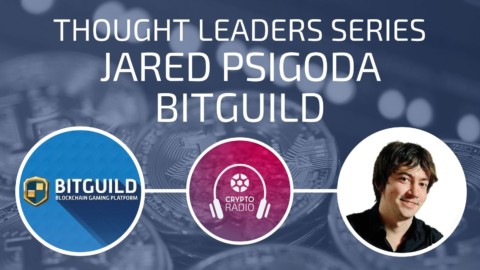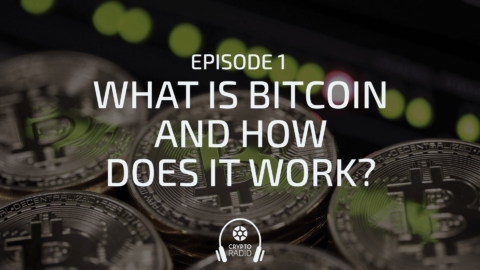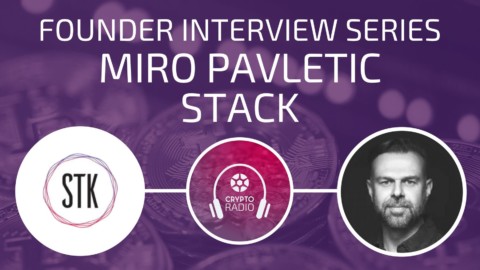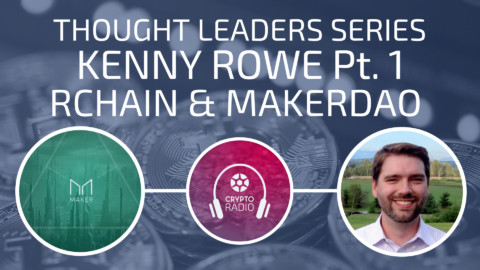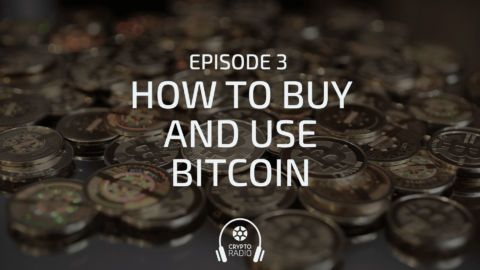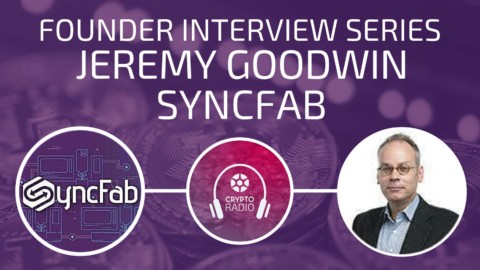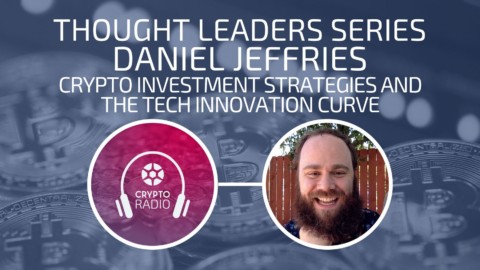Podcast: Play in new window | Download
Chris: Hi and welcome to Crypto Radio. My name is Chris Sparks. In this episode Euvie, Mike, and I welcome Dean Masley and Nathalie Drost, the co-founders of NestEgg. NestEgg explores the use of blockchain to empower individuals [00:01:00] to make better investment decisions within their pension. Much of what they do involves co-ownership and using blockchain technology to make certain investments more accessible to average people which would otherwise be unavailable.
We cover a lot in this episode, including what decentralization means for our daily lives, the limits of blockchain and managing big data, what automation will bring in the future, and how the economy can be more inclusive. Although NestEgg is a relatively new project in the blockchain space, the experiments they are running promise [00:01:30] interesting models for how to invest in and own your future in an entirely new way. Enjoy the conversation. For the show note and links mentioned in this episode don’t forget to go to cryptoradio.io/nestegg.
Mike: Alright guys, welcome to the show. Dean, you’re one of the founders of NestEgg. We watched you speak, we’ve seen you at a bunch of conferences all over Europe and I’ve really been fascinated by your ideas when it comes to the blockchain. You’re obviously a bit younger in this space [00:02:00] and I like the connections that you’ve talked about in the community and your perspective in this space. We’ve invited you onto this show and you’ve got Nathalie obviously with you. Before we get started, why don’t you guys just give us a quick introduction to who you are what NestEgg is all about.
Nathalie: My name is Nathalie. I’m co-founder of NestEgg together with Dean and another guy. I graduated master of business of administration, but during my masters I wrote my master thesis about hybrid banking. It’s kind of what is the future of banking look like, and I came up with a solution that was decoupled from the Euro, [00:02:30] paying with services and then, of course, that relates to blockchain so I found out I made the system many conditions for building on blockchain. Then I met Dean on Bitcoin [inaudible [0:02:39] in Amsterdam, he was a speaker there and I was co-hosting it. After that, he introduced me to the blockchain education network. I then set up together with Dean the [inaudible [0:02:47]. We enrolled for Hackathon and we won the Hackathon, and that was with NestEgg. That’s the idea we’re working on now.
Dean: Yeah. I’m Dean Masley, I’m the American. I was the last executive director of the blockchain education network. [00:03:00] I’ve always been really interested in grassroots blockchain efforts. I was also part of [inaudible [0:03:05]. I’ve always been very into entrepreneurial efforts. I’ve been really fascinated by using blockchain to solve problems because it’s such a new technology and offers so much potential, and there’s not many people who are, well, now there’s more people using it, but it’s still something that there’s a lot of opportunity for cool stories and cool successes because it’s still so untested ground. It’s a blue ocean of opportunity and it’s cool to be able to build these new infrastructures with this technology.
NestEgg is helping [00:03:30] individuals invest in the future of innovative infrastructure. The incentive is that in doing so, you guarantee yourself ownership of the productive capacity. Meaning, you can reduce your cost of living by owning pieces of infrastructure that provide for you every day needs. For example, if you want to supply your home with energy with some kilowatt hours, you purchase some ownership in different windmills. Let’s say you purchase one percent in one windmill here, one percent there. Every time that windmill spins, you get one percent of the energy generated from that spin. Doesn’t matter what the price of that energy is because you own a percentage of that windmill, so you own a percentage of its capacity [00:04:00] no matter the fluctuation of market price or government volatility.
You own that one percent, so your house will always receive that one percent of the windmill, whatever generates. Same thing, then you can apply it for self-driving cars and transport around town or real estate and the ability to maybe have a decentralized Air BnB that’s not very well scoped out. The idea is that there’s a lot of things that we need to build for the third industrial revolution to make sure that we can completely transform the way we consume energy, we transport ourselves around, and communicate with each other to build the infrastructure that supplies all that needs a lot of different people [00:04:30] contributing small amounts.
And the incentive to do so is that they will own pieces of that infrastructure once it’s built. In doing so, they secure their future life security because these infrastructures will provide all their daily needs. Then they’re opt in a price at a much earlier date, so as the dollar keeps inflating or the euro keeps inflating, they’ll have locked in their price, for example, that windmill. So, they’ll keep that energy price within a good year or two forward.
Mike: Very cool, very cool. So, what’s the status of this project right now?
Nathalie: It’s not an ambition because the technology we pretty much have figured out, but the thing is you also need the legal environments [00:05:00] to accept that you pay out in kilowatt hours and not in euros. So, there’s a lot of obstacles to overcome in that sense, but to prepare for that we’re starting small experiments in which we test the customer feedback to build a product that’s best for the customer to see how they interact with other owners. So, how do people go about sharing ownership, how do they [inaudible [0:05:17]:18] the value, how do we make this as customer-friendly as possible. While doing that, in the mean time we’re figuring out where can we actually put this live, under what circumstances, what’s going to be the projects that we’re investing in by then.
[00:05:30] Currently, our biggest project coming up is solar panels. We’re trying to put them on the roof of Brightlands, the campus we work on in [inaudible [0:05:37], and have the community invest in that because it shows the effort of something that’s really in a proposition. It’s still in kind of a safe base where we don’t have to have every legal aspect figured out to be able to do so. So, it’s really working to the proposition while, along the way, figuring out all the tiny steps or big steps.
Mike: Very cool. What kind of partnerships do you guys have in place for it now?
Dean: Right now, we’ve been talking with a few companies. We’ve been talking with, for example, energy providers. [00:06:00] So, companies that deliver energy from the grid, that’d be a really important process that we’re doing, kilowatt hour credits that you can have kilowatt hours delivered to your house, we need to deliver to the grid. We’ve been talking with mobility companies. So, there’s companies [inaudible [0:06:13] that do, you know, you can rent Tesla’s, for example.
There’s also, as I said before earlier, [inaudible [0:06:20]. We’re not partnering with them right away but we’re interested, for example, in their proposition of deploying self-driving cars in community that are crowdfunded by the individuals.
Nathalie: Yeah, our main partner everywhere who helps us in [00:06:30] developing our proposition is a pension service provider in the Netherlands. They serve four and a half million customers. They have the financial institutional knowledge of how it’s currently being done. We get a lot of help from them in the legal environments and the portfolio manager [inaudible [0:06:45], like those people who help us in that partnership.
Dean: That’s a good point. To clarify, we actually started this about a year ago at a Hackathon working in the future of pensions track, where we proposed the seed of this idea. Then ABG hired us onto [inaudible [0:06:58] building this as an experiment [00:07:00] and then plan for scale out, which means become our own company.
Mike: Cool. What excites you most about this space?
Dean: For me, I’m really excited just seeing so many people, especially young people, feeling the confidence and the authority to attack problems that seem so much larger than themselves. It’s really cool to see the use of community dynamics to basically inspire a larger group of people than yourself and using these kind of open source platforms to get their ideas, their thoughts, their governance into your platforms. Your idea can actually grow into [00:07:30] incorporating all this local input and the way that people are going to use that in their every day lives. I think this is much different than the traditional way of doing things in which you have to build a huge hierarchy, build the entire stack yourself, be a boss who can control things and every last detail.
I think there’s an interesting shift in strategy that leverages the way the internet distributes information and people can tap into that by building platforms that – or, achieving problems much bigger than themselves by giving the tools to people who need it most. Whether that’s in America or in Africa, being able to do these value transfer programmably over the internet has offered some really, really cool [00:08:00] opportunities.
Mike: Yeah. How long have you guys actually been in this space for?
Nathalie: A little over two years for me.
Dean: Yeah. I’ve been around since 2013.
Mike: You’ve been in long enough to see the evolution of it already. Did you notice at the beginning it was anarchistic, a lot more independent, a lot more programmers and now, when you go to events and conferences, there’s a lot more banker, investor focused?
Dean: Absolutely. I still remember buying some honey off some dude on Reddit back in 2013. I did some graphic design work so I had some Bitcoin. I didn’t know where to spend it and some dude on Reddit was selling honey [00:08:30] from his farm. I ended up having it shipped to my house. I thought that was the coolest thing, that I used this alternative money to actually buy a real-world thing.
Mike: Let me guess, it cost you like 30 Bitcoin?
Dean: Luckily, Bitcoin was around $100 at the time. No, luckily it wasn’t that dramatic but I still remember the feeling of feeling it was so cool to have this financial transaction done without any actual currency but using this kind of social experiment of a technology. To see where it’s come now today from that is really spectacular.
Nathalie: [00:09:00] It’s really interesting you mention because when I went to the first conference, it was really people in t-shirts promoting their system or their use-case. I just yesterday came back from Crypto Assets Conference in Frankfurt and that was pretty much all suits. It’s really shifting towards different [inaudible [0:09:15] industry you don’t really know what to do with it. When you go to conference anymore, I just feel they work on their use-case and what they believe in.
Mike: Being that you’ve been in this space for a while but you’re on the younger side of the people involved in this space now, what do you notice about the evolution [00:09:30] of this space and what do you notice about the differences in mentality between older generations and younger generations?
Nathalie: What I feel is that the younger generation is a bit earlier in understanding that it’s not so much about technology, we know it works and there’s stuff to overcome but we just build it and we want to try use cases. Whereas, I really see the older generation trying to make the link with the current system and really, “What’s technology about? How can we make standards for it? How can we discover what’s all in it?” It’s really the difference of let’s just go at it or let’s [00:10:00] find out how it affects us. That I really notice being younger.
Mike: I remember when we first bet you, you were talking about the groups that you were in and the communities and how young people were getting involved. I remember how excited you were when you were describing the communities and the mentality in this space. So, that’s really why I asked that question.
Dean: Yeah. In that context, it’s really cool to see all these different groups of people being able to connect with each other, because you can have a local initiative in which I always call this bottom up globalization where you have local first initiatives, which really address the problems in your community. [00:10:30] You use all the things that are available to you in your community. In the Netherlands you have really awesome payment rails, like Ideal. You can literally pay someone with this fearless transaction that’s different than America, for example, where I pay my rent with a paper check that I actually would physically deliver to my landlord.
So, different communities have different obstacles and challenges that they have that they can use the technology to address those very uniquely. Yet, using this technology that’s global whenever they solve these problems locally with this global technology, they create this inner connective hub which brings them altogether and enable them to [00:11:00] cross in different cities, use the currency natively, use solutions they built in their hometown and it works in those other hometowns. In doing so, you create this global community of people working on local problems that affects everyone globally.
I like that model a lot better than a top down approach, like big institutions trying to implement big, big hierarchy or overarching details locally in a community like how your soap, what chemicals are inside of them. Not that that’s a bad idea, but just as an alternative of handling things local and going up versus top down.
Mike: Do you think that’s how you guys are approaching things with NestEgg?
Dean: [00:11:30] It’s hard to say. It’s easier to obviously make that argument with the blockchain education network, where we’re actually sending out kids in different university campuses. There’s some bottlenecks with building infrastructure where we do need some bit of work with people who are already in the field who are building windmills or solar panels or self-driving cars. I would still say there’s definitely the element of bottom up building in terms of we don’t aim to supply every windmill on the earth. NestEgg doesn’t plan to just supply every self-driving car on the Earth.
Unlike Uber, which plans to do that exact thing. We plan to work with all the self-driving car [00:12:00] companies or [inaudible [0:12:01], which is launching in Paris and they want to do a test-drive on [inaudible [0:12:03], which is a self-driving car blockchain platform. We want to work with those people to help them scale their infrastructure plans and not try to do this alone.
Chris: Dean, I just was wondering actually, have you noticed any difference in the way that people talk about blockchain in the US versus in the Netherlands or the EU at large?
Dean: Very interesting. My own experience was that, as I said before with my payment rail in America, Bitcoin for me was actually fun to use as a real way to transfer money. [00:12:30] It was either Venmo, PayPal, or that I was pushing Bitcoin. But in America, you can’t very easily transfer money from bank account to bank account. I was actually most often pitching it in America as an easy way to send money around, but here in the Netherlands, that’s really not the case. Nathalie, how would you describe your fascination with blockchain here?
Nathalie: I’ve noticed that, the second time I bet Dean was in London at the conference, we spent 12 [inaudible [0:12:50] we shared an Air BnB house. Normally, I was just used to sending Ideal payments to cover it but now there were Americans in it, as well. Then Bitcoin was a really good use [00:13:00] case because otherwise there was no good real way of doing so. But indeed, for me, Bitcoin had more of the idealistic values than really being so fast as a payment thing because, indeed, Ideal was almost just as a fast, it doesn’t cost any transaction fees. Or, at least, not as a seed. So, for me it was more realistic of what you could do with it than for being more of like, “This is really cool, this really works that fast.”
Mike: The entrepreneurial ability.
Nathalie: Exactly, more technology.
Chris: I guess I’m also interested I hearing the less tangible feeling [00:13:30] that you get from the community in the US versus the one in Europe? Do people talk about it in an existential sort of dreamy way in one place and not in the other? What’s the vibe of the community in one context and the other?
Dean: It’s hard for me to say. I built myself quite a bubble in terms of surrounding myself with crazy blockchain people. So, the people I talk to are very visionary and like to talk about how they’re going to change the world. I don’t want to say that that’s reflective of the entire United States or of different demographics, but I would say from the people I’ve met in [00:14:00] MIT or from Berkeley, for example, whenever we talk crypto it is very visionary.
I don’t know if that’s the right word. The most ideals of this technology. In Europe you definitely find people who are doing the same, too, but I would think there’s also a bigger stress on applying it right now in existing infrastructures. Maybe a little more down to earth. At that point, I’m hesitating while I say that because I don’t want to make too many generalizations.
Nathalie: No, I think that’s pretty accurate. When I came into this space and I wanted to do something more with it, someone told me, “Go to America because shit happens there.” [00:14:30] Then afterwards, I realized that, yeah, there is a lot happening in blockchain space in the US but since everyone can just plug into it, right, it pretty much happens in China as much as it does in America. But without generalizing, I do like to say, indeed, that we might be a bit more pragmatic here. When traveling in America, I noticed more of the anarchy way.
Dean: More the moon shots.
Nathalie: Yes.
Dean: Going for the biggest idea and no one can get in the way.
Chris: Exactly.
Dean: If you fail, you’ll get up and try again.
Chris: Shit definitely does happen in the US.
Dean: Yes.
Chris: Not necessarily in a good way [00:15:00] but yeah.
Euvie: Do you think that they’re going to get a reality check with those moon shots pretty soon?
Dean: My personal opinion, I don’t necessarily think that moon shots are the worst idea. I think a lot of projects, there’s going to be a lot of failures but also, I think the most successful ones are going to be considered moon shots historically. If you were to say… I think future successful platforms like [inaudible [0:15:21], for example, I’m pretty bullish about. I think that platform when it was communicated a while back did have to go through its fair share of fighting against the grain. In doing so, I think they defended their moon shot quite well. [00:15:30] I don’t particularly see the moon shot thing dying down but personally that, to me, isn’t necessarily the worst thing. I think it’s okay if you have a lot of failures. People get up and try again later. It’s a matter of attempting these big things.
Nathalie: I think in terms of a reality check, the people in the industry should go out for what they want because when you looked at the internet they also said, “It’s going to give everyone access and it’s going to help the poor,” and all those things. Now, again, right, blockchain does say, “Half the world doesn’t own a bank account. With blockchain, you just need the internet and you can access Bitcoin.” It’s true but if you can access Bitcoin, you assumedly don’t have [00:16:00] $10 for a transaction fee to spend, right? So, I think in terms of reality check, we should go out for who we actually built this for and if we say it’s going to bring inclusivity, then let’s really evaluate how to do it. So, in that sense, yeah.
Chris: What sort of safeguards does blockchain have against centralization of power in blockchain, where in the internet case they’ve kind of centralized? Google and Facebook have done a really good job of centralizing the internet for them.
Dean: I think from the get go, for example, even when we were building NestEgg, there’s all these [00:16:30] companies that are working on trying to build how do fractionalize the ownership in different productive infrastructures. Especially the energy sector alone. There’s plenty. There’s [inaudible [0:16:39]. The cool thing is that all these companies release all their plans up front in the open to the public, their full business strategy. If they have any code, anything that’s already built is out there in the open. Also, a strong priority on getting community involved and having them impact the business decisions of the platform. I think that’s the beginning of countering that.
Nathalie: But also safeguards, I remember [00:17:00] coming into this industry and I talked with someone who was already in it for longer and I asked, “What if whatever government just says, ‘You cannot use Bitcoin, otherwise we’ll put you in jail.’ Isn’t that the end of Bitcoin?” It’s one of the first questions that came to my mind. What he said I’ll always remember that afterwards. It’s like, yes, they could do that, but then there will be another coin which is so fast and so much more anonymous that it just will go on with that one.
That made me realize for the first time like, “Shit, it’s really decentralized.” Decentralized meaning in the sense that you don’t [00:17:30] need safeguards because you just need your own mobile phone and your internet connection. With Cheat Cash coming up, and likely more coins in the future, there’s no way to [inaudible [0:17:37] to take that share.
Mike: I think culture plays a big role in this, too. All of us in this space now appreciate the transparency and decentralization, but I wonder if the general public is going to care as this adoption increases. It’s like, I could see different companies that are quite a lot more centralized and controlling just building some sort of equivalent application on the blockchain but still maintaining a degree [00:18:00] of control. It really depends on how the culture evolves with the technology. Are we going to still value these things as highly as we do today?
Nathalie: I think it’s a very good point, because we work in the pension industry and it’s kind of the same, people are not involved with their pensions. Part of the problem is that there’s no transparency. But they realize that if you provide transparency, people don’t care. I think that’s a very good point you make is that we honestly believe in it but I hope this time it’s different, because the tool is so natively transparent. Not like [00:18:30] putting on top of it but it already is. This time, it does make a change and that people trust it. Definitely, that needs to show over time.
Mike: I think your earlier point about bottom up entrepreneurship and innovation is a really important thing. Especially as the tools and the funding become more accessible all over the world. It’s going to be interesting to see what people create and how little of the value and the platform they’re trying to capture for themselves and how much they’re just willing to give to the general public.
Dean: I think that’s a great way of putting it. It’s like all this information, all these valuable things. For example, [00:19:00] when a platform like a self-driven car is doing their transaction on the blockchain, that means every ride, every dividend, who’s getting what, all that economic activity is live, and everyone can view it. For example, when I used to work at Gore, we payed an ungodly amount of sum of money for [inaudible [0:19:15] to run these huge, huge market trials to try and get information from the consumers about what they thought about which jackets they liked to buy and etcetera.
The thing is, it’s like, because that information is private, only experts like a big company like Gore can afford for the market research [00:19:30] to make action on those researches. Everyone else then just follows Gore. So, that model, for example, only works when the data’s hidden, because then you can actually capture [inaudible [0:19:39]. Having this information publicly and then out in the open definitely makes it easier for more entrepreneurs to use it for building new apps or what have you.
Mike: I love the idea of information and processing power being also one of the things that are distributed on the blockchain, because then we have a situation like what Jeremy [inaudible [0:19:56] wrote about in Zero Marginal Cost Society where the competition of these [00:20:00] different platforms is causing the cost of using those platforms to plummet. It’s like the only platforms and applications that are going to be able to be competitive are ones that are truly decentralized, where the information is free, the access is next to nothing, or the minimal possible transaction.
If there is a middle man attempting to capture some of that percentage of value for himself, then he’s going to be outcompeted by some kid who’s using the same data set to create an application but not [00:20:30] taking a percentage of any of the transactions. It’s like you just simply won’t be able to compete on margin anymore.
Nathalie: That’s a really cool thing.
Dean: If you have to build your own PayPal servers to run all the things the blockchain normally does, or you can implement an API and the blockchain does it for you, one requires a lot of money to get started and the other doesn’t.
Mike: Exactly.
Euvie: You mentioned the data being publicly available on the blockchain. What kind of applications do you see for big data in blockchain?
Dean: I think just on a more high overview basis, it’s just having more access to information lets you find efficiencies better. [00:21:00] Like, more people are looking at massive streams of data and more people are running analysis on those things, it’s more likely that people are going to find areas where things are being done inefficiently where maybe costs could be reduced and things are maybe taken too many steps or being sent to the wrong parties or they could be aggregated. Just in general, having that much more eyes on that much more data is bound to produce efficiencies in the way we produce things and transfer things.
Nathalie: I do like to play the devil’s advocate here because data and blockchain don’t necessarily go together that well in the sense that it’s decentralized and putting more data in [00:21:30] makes it more slow. It’s not that scalable. I think it’s good for some use cases, but when you look at big data I doubt it. It really depends on what you’re trying to prove. It offers more transparency but only through very specific things in my opinion.
Euvie: Can you elaborate on that a bit more? What kind of use cases is it useful in terms of data on the blockchain?
Nathalie: I would say any transfer of value. That doesn’t necessarily need to be monetary, it could also be non-monetary or infrastructure or any kind of service. That transfer of value actually just relates to ownership and whether it’s money or just numbers, [00:22:00] in the case of blockchain. I think that’s really important. You will see that, in any industry, you will see it for land ownership rights, you will see it for who owes somebody what money. All those cases. But when looking at data, what the ownership actually entails or under what circumstances or whatever, I think that will be never something that’s on chain and also not really needed. Because if the ownership is registered, that’s the thing that’s mainly important.
Dean: Yeah, I think scalability is also a huge elephant in the room for all these discussions about the use of big data and blockchain, because yeah, as [inaudible [0:22:28] makes a good point, [00:22:30] even my argument of having economic data being available to everyone is impossible if it’s not scalable enough to actually accommodate all that data.
Nathalie: You have ways around it, right, you can store it, for example, and then you can see the calculation elsewhere. There’s already alternatives for it and also believe that we’re going to see solutions for scalability in the future very soon. The thing is that centralized is obviously more efficient that decentralized. It’s just what are the benefits trying to achieve, because I always try to say, “How efficient is it if I want to send 50c to Dean and the whole neighbourhood needs to [00:23:00] check my transaction?” It does offer so many other advantages. If people say, “We need a scalable blockchain,” it’s like, wait a second, you’ve got to set your priorities straight and realize that maybe it’s not scalable but it offers advantages that you otherwise wouldn’t have had, because that’s the whole point why we’re going to decentralize.
Chris: Moving away from efficiencies and scaling, you guys definitely have an intimate connection with your customer in the actual use of your platform. What role have you noticed user experience and design playing actually in your project?
Dean: Actually, we had one kind of [00:23:30] rough draft of an experiment where we had people share a drone. Basically, the idea is that before we start doing windmills and solar panels, which cost quite a bit of money, a windmill is like 2.2 million euros, let’s start with something a little bit smaller and see if we can get people to locally share something like a big drone. Or, coming up actually in this next month we want to have people share access to a virtual reality [inaudible [0:23:50].
We’re going to be testing these concepts of is it possible to find the right amount of people who are enthusiastic about a thing, make sure they have perfectly matching schedules that are automatically organized by the system [00:24:00] so that each of them can pay just the amount that they’re using. In doing so, they can pay the reduced price for the access that they would normally have wanted anyways. When we set up those experiments, we did the one with the drone.
From our experience there, the actual user experience we needed to work on incredibly. We really just threw it up there using a few smart contracts, we used a few data bases to organize the incoming data but the biggest complaint was user experience. That makes sense because we actually had people going on through My Ether Wallet, adjusting the smart contract and such. That was pretty obvious.
Nathalie: [00:24:30] Yeah, obviously you love your own product so you expect customers to love it the same. We realized we really built super customer-unfriendly. We found that customers, if they cannot find it out in 30 seconds they pretty much skip it up. We had them sign up with My Ether Wallet and actually buy Ether. When it’s someone’s first interaction with blockchain, which is already a super [inaudible [0:24:50], right?
Dean: Imagine us, we had to write medium articles of how to go into Litebit, how to give information away so you can pay with a bank account. It’s easy stuff when [00:25:00] you know it but then when you realize you’re trying to explain it for the first time to someone, to access your platform, you realize that gateways are super important to let people with euros have access to these Ethereum gaps, even before the public has Ethereum. That was a pretty crucial realization that even though all the benefits come from being on Ethereum, we need a gateway to make sure that people with euros have access to it.
Mike: Yeah, it’s like asking someone to send you an email when they’ve never used a computer before.
Dean: Right.
Nathalie: Yeah, that’s a very good analysis, yeah. We definitely learned from it.
Dean: Right now, the scope for the next experiment is [00:25:30] how can we accommodate that by adding gateways so that we can easily let people use euros and we’ll handle all the messy stuff to make sure that you get the experience that we’re promising everyone else.
Chris: Without divulging too much IP, would you be able to tell us a little bit about what the gateway would look like?
Dean: It’s two functions. One, for example, is for us to do a lot of the stuff on our back end, like bulking transactions, aggregating users funds, and making one single transaction on behalf of a bunch of users. Then, of course, then it’s just like Coinbase. In Coinbase [00:26:00] it’s not like you have an address and that address holds the Bitcoin the whole time. Coinbase will move money around, so you might be able to receive money from an address but your money is not held in that just one address, it’s held on an off-chain database entry of your actual user balance.
The actual transfer of value that are important in and out of the system is on blockchain. Then once you’re within Coinbase, if you send it between Coinbase, you just, for example, that’s all off-chain for free. We think that’s an interesting model and we’re looking into that. For our experiment we’re going to be bulking transactions together, so people who use euros, we’ll be able to aggregate all their things and [00:26:30] initiate one single transaction to the crowdfund, for example. In doing so, we trigger all the transparent audit trail of one transfer of ownership and transfer of funds.
Yet, on our system, the users will have feedless transfers between each other and the dividends and all that stuff will be handled on our server. Another way is to also accommodate, especially as we scale beyond different jurisdictions, is simply adding gateways to our platforms. I mean like Litebit, [inaudible [0:26:53], those are companies that let people in the Netherlands, for example, transfer euros for Ether [00:27:00] back and forth. If we attach those on different ends of the ecosystem and we use a stable coin in between that could also allow us to make sure that users have euros that they can convert at the end or the edge of the ecosystem.
Then while it’s in the system, we can use a stable coin to make sure that while it’s running through the blockchain, giving it that transparency and auditability, the value is held relatively constant so that when it comes out the other end it’ll be able to be transferred for the right around of euros. Still a lot to be discovered and we’re still working on it.
Nathalie: Yeah, I think what Dean very well explains is [00:27:30] actually making a link to the old worlds. We prefer to just have people buying directly as we did with drone share, but we just found people are not familiar with it yet, nor maybe know how it works or trust it. They just say, “Can I just give you euros and you do it for me?” Yeah, we really need a gateway with the old world and hopefully some time in the future that they can just directly buy into a smart contract.
Chris: What would the gateway look like?
Dean: To scope out the problem of what the stable coin is used for, the problem is that, as we said, users have euros, and using the [00:28:00] example that we had earlier if they don’t have Ether to buy into these things how are they going to participate in the ICO? We can’t just lock out non-crypto owners from this infrastructure revolution. We need to find a way to make sure that users can use euros to purchase these things. Additionally, the infrastructure providers, the person who’s raising this money for this new windmill or solar panel they want to build, they also need to receive euros or some stable value at the end of the crowdfund, because that’s what they use to purchase the infrastructure with.
You can’t buy a windmill [00:28:30] with dye or with tether, not that we would want to use tether, for example. That’s where the gateway is and the problem of stable coin is really relevant because the benefit of using the blockchain is that all the important economic activity is transparent, it’s auditable, the system is accessible basically where there’s internet, if we want to set it up that way. But then to accommodate the problem of when users need euros or want to spend euros and the infrastructure provider needs to buy their infrastructure in euros, we need to attach gateways and use a stable coin while it’s being run through the blockchain [00:29:00] so that we can make sure it comes out as the same euro value.
Chris: So, it comes out the same way it goes in so that people can’t really notice that you’re actually using a blockchain, a stable coin, a wallet, and a smart contract.
Dean: Right. Except it is important because in doing so, people can trade their Ownership values without us necessarily, the actual dividend can be distributed automatically for a smart contract that takes a bulk amount and sends it directly to token holders. The crowdfund can be viewed and people can trust that the funds in will get the appropriate shares of ownership out, all that [00:29:30] activity will be done automatically, programmically.
Nathalie: Yeah, you want to do it with a stable value because if you do Ether or Bitcoin, in a good scenario they get more money out of it but in a bad scenario the money is worth less.
Dean: That’d be pretty bad if the crowdfund finished and you can’t buy your windmill because the price tanked 10 percent or something.
Nathalie: That’s actually the reason behind it.
Mike: I’m wondering if you guys can tell us about your vision of the future? What does NestEgg look like with a lot more adoption and what do you think the future of blockchain in this whole industry looks like, say, [00:30:00] two to five years from now?
Nathalie: I really believe we’re moving towards a future which is way more automated in the sense that I’m not worried but I think that we will see people losing their jobs faster than we can actually provide an alternative. There’s alternatives being proposed, like universal basic income and the sharing economy. It sounds cool and there are attempts, like Uber and Air BnB but they’re not actually sharing. If you think that they are just in the middle taking the value and start taking more. I think it’s a combination of those two which we need to pursue in order to [00:30:30] make the future as we want it.
Otherwise, I don’t know what the world’s looking like if people lose their jobs and there’s no alternative. I think if you combine those efforts then you could make a universal basic income, universal basic services, and that’s why I’m pursuing it in this goal together with this cool team. I think that is a solution in which people can, during the time they still have their jobs, invest in this infrastructure and get the services accordingly.
Mike: What’s preventing people from, say, buying up all the windmills, one [00:31:00] rich guy buys all of it, do you guys have mechanisms in place so that you prevent that hyper-centralization of ownership.
Dean: It’s really funny you brought that up. A lot of people brought that up and I think it’s a good question and it brings up the point of what happens if it just ends up being the same as it was. I think the difference is that in doing so, even if that’s the case, one, I don’t think it’s going to happen because, like, Uber’s trying to produce all the cars for all transport, right? Their deployment is huge but it doesn’t even scratch the surface in terms of what they need to accomplish. Same for any rich person, they could not physically buy all the [00:31:30] windmills necessary for all the communities.
I think, at best, if someone does want to make a huge impact and start buying all these things it would end up just creating a lot of innovative infrastructure and the access to these infrastructures are then much more accessible. Because you do it in a way where the actual dividend is tokenized, it’s recorded, it’s easily tradable, so that you can actually find the right owner at the right time to purchase it even if they don’t have the original ownership token. The ownership token is just how you get the dividend initially.
After that, you have the choice of do you want to use this dividend like a kilowatt hour to power your home, or do you want to sell it on the open market so someone else can power their home with that kilowatt hour. [00:32:00] In setting it up with this framework, even if one person buys up a bunch of infrastructure and gets all this credit, they can’t power their home with all those windmills, they have way too much energy. So, they’re going to be selling it back onto other people and in doing so you’re going to create market dynamics that hopefully bring the commodity down to a zero-marginal cost.
Mike: I wonder what if, say, it’s not economical to have energy coming in from communities at a larger distance and one guy in one community buys up all the windmills. What does that situation look like to you?
Dean: [00:32:30] Then also that community has a bunch of windmills, right? Then that community now has a bunch of windmills that are funded up front. That fits my argument but also…
Nathalie: No, I think like I said this is a good point that brings up a problem. I think it’s a big trial and error in the sense that we should see if this actually happens. If this actually happens, you could foresee in, say, a person can only buy an X amount of share of a windmill and that’s just the max because we want to keep it as decentralized as possible.
Mike: That’s cool.
Nathalie: I see these arguments, as well, I just really wonder how it plays out. We will have to see and see how we respond to it.
Mike: [00:33:00] I’m really seeing how critical it is to have the identity component for any start up in this space if you want to limit hyper-centralization, because if you have the identity component and you want to limit it to a percentage of ownership then you need to ensure that it’s not one guy who’s owning like 30 different wallets and sending in and still monopolizing.
Dean: True. Those are things we can address. Hopefully, if it’s being done transparently, we can attack every single vector of centralization or if we see all these flows of [00:33:30] money going to a single wallet and stuff, you can have an open conversation about that. At least beforehand that wasn’t possible.
Mike: Yeah. Final question, what kind of questions do you wish more people would ask you when they’re asking about your ideas about blockchain or about NestEgg? What are questions you don’t get that you wish you would get more?
Nathalie: Maybe not necessarily questions that people ask, but I’d like to hear what they see in it and how they see their role in this future. Getting customer feedback is key. We can build this future but it’s us together doing it, so really need the customers to think like that. [00:34:00] Maybe not them asking us a question but really them saying what they need in their community or what they need in their daily life so we can better account for that in our product.
Dean: Also, to add onto that, in doing so the biggest things we scoped out, for example in NestEgg, is energy and transport but there’s obviously tons of other infrastructure that is really relevant for building up this future third industrial revolution where everything is shared and accessible and uses IOT to make sure it’s in the right place at the right time and you can pay what you want. It’s not just cars, it’s not just energy, so it would be interesting [00:34:30] to see what other infrastructures people think are relevant to this vision and see what types of things they would like to see become created.
Mike: Alright guys. How can people get a hold of you and find you online?
Dean: Nestegg.eu.
Nathalie: Not the NestEgg as in the American one but NestEgg with ‘Egg’.
Mike: Alright guys, thanks a lot for joining us on the show, it was really nice having you. It’s nice hearing your perspective about the future and what you guys are doing with NestEgg. It’s really inspiring, thank you.
Dean: Cool. Yeah, thanks so much for reaching out to us, we appreciate it. [00:35:00]
Dean Masley and Nathalie Drost of NestEgg share their vision in decentralized ownership of infrastructure assets on the blockchain.
NestEgg is a relatively young project in the blockchain space, which won a hackathon in the Netherlands, and is currently being developed in collaboration with the APG pension fund. It experiments with investing in and co-owning green energy assets, houses, public transport, self-driving cars and other infrastructure capacities. As Nathalie and Dean explain, the aim of the project is to make these pieces of infrastructure accessible to ordinary people, so they can reduce their costs of living in the future.
The idea of investing in a sustainable futures took us into to a deeper discussion on the most exciting aspects of the blockchain space and technology, as well as the problems and limitations that may or may not be overcome with its wider adoption.
What we cover in this episode
- Advantages of the bottom-up development in the blockchain space
- Evolution of the blockchain space from idealism to pragmatism
- Cultural differences between Europe and US in approaching blockchain
- Degree of decentralization – a competitive strategy in the future crypto market
- Possible applications of big data
- How to prevent hypercentralization of the ownership in NestEgg and related projects
- User experience as a big challenge for NestEgg
- NestEgg’s current status and established partnerships
- Share economy and universal basic income as future solutions to rising automation and loss of jobs
Resources
- NestEgg website
- Unsung.org – food redistribution blockchain project
- Blockchain Education Network
- Mobotiq – peer-to-peer mobility operator
- Brightlands sustainable technology incubator
- Crypto Radio Thought Leaders Series


